Genre: Fiction
GoodReads meta-data is 416 pages, rated 3.8/5 from 1573 litizens.
Verdict: Quite a ride. Best to have a scorecard of the names and places.
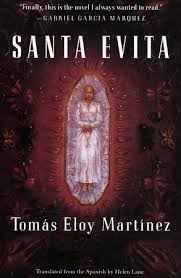
The novel offers an examination of the place of Eva Perón (1919-1952) in the soul of Argentina and Argentines. Eva is dead. Long live Evita!
While there are retrospective glimpses of young Eva growing up, meeting and marrying Juan Perón and ruling with him, and her earlier career on radio and in films, most of the book concerns her afterlife.
When she died Perón went through the stages of grief, culminating in the plan to build a giant mausoleum to her memory. Barely had the ground been cleared in central Buenos Aires for the building when Perón was toppled in yet another military coup. (For what it is worth he won the popular vote in three elections.)
The plotters were at odds among themselves in every way but united in one. Above all else every trace of the Peróns, both of them, had to be erased immediately, least their followers, who were undoubtedly the majority of the populace, rally to the remaining symbols. Street signs, building names, charitable foundations, orphanages, schools that bore the name Perón, all of these had to go. Over night school teachers were required to mark out their names in every scrap of instructional material. Republicans have been doing likewise regarding Obama.
 The youthful Eva.
The youthful Eva.
No symbol of Perónism was more important than Eva herself. At her death Perón had set about having her mummified like Lenin and to be put in a glass sarcophagus on display to the faithful. He had seen the thousands come to mourn her as she lay in state, and since there was demand he set about supplying it. Work had begun on that. There was also a nascent plan to produce wax replicas, least the body decay despite the preservation. Remember Jeremy Bentham?
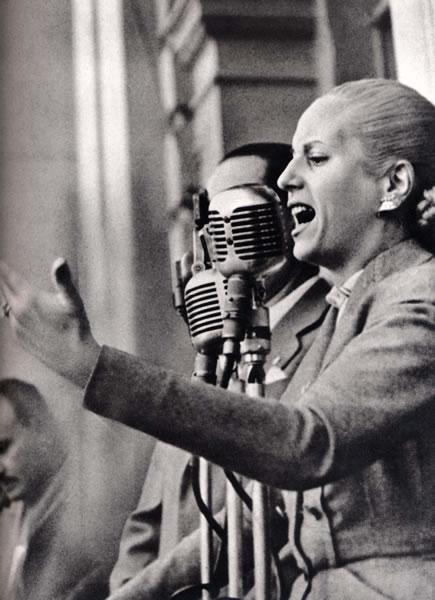 She spoke.
She spoke.
 They listened.
They listened.
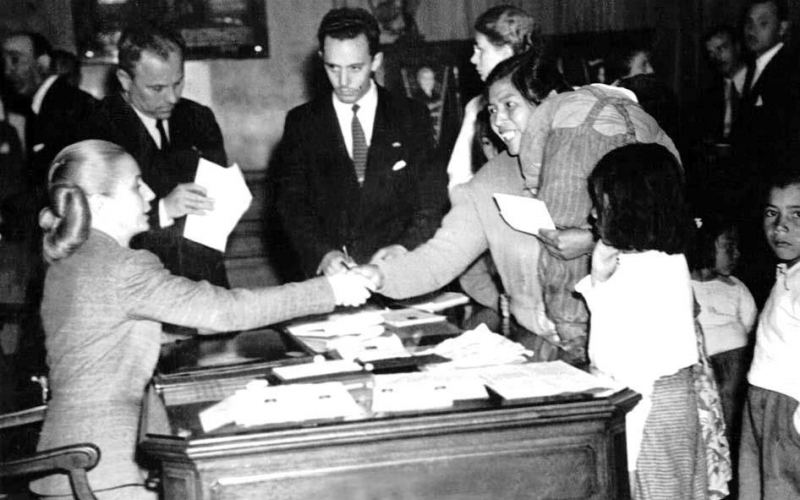 They came; she gave.
They came; she gave.
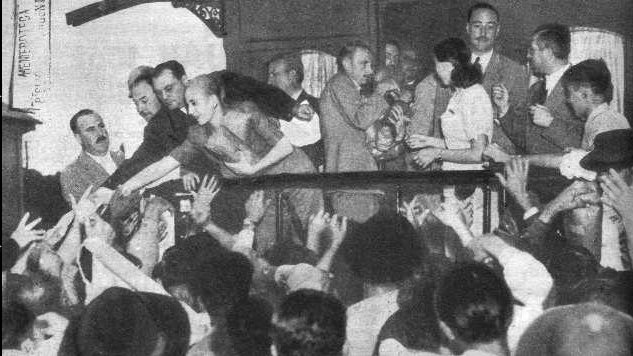 Even the touch was enough.
Even the touch was enough.
Some of this work of preservation had been done in secret and later amid the turmoil of the coup which was followed by an in-house palace revolution by another faction. Moreover some of those trusted with the cadaver tried to hide it from the usurpers. When usurpers found it, they in their turn tried to hide it. In short, the body got lost for many months. When it was discovered the new regime was in a quandary about what to do with it. Unsure even if it was the real thing. More hiding followed.
To desecrate it would call down the wraith of the Catholic faithful and the electoral majority of Perónistas. To bury it would create a site of Perón pilgrimage. To hide it indefinitely in a time of coup and counter-coup would not suffice. To comply with Perón’s plea from his roaming exile to send the body to him would put a potent symbol at his disposal.
From these chemicals Eloy Martínez compounds quite a story as he enters into the minds and souls of the morticians, embalmers, army officers and soldiers, on-lookers, janitors, true believers, by-standers, journalists, and foreign diplomats who come into contact with the mystery train transporting the cadaver or one of its several replicas.
To summarise what cannot be summarised, thinking takes time and initially during the thinking time a squad and a colonel, low enough in rank that he could not reject the assignment, drive the cadaver in a coffin around in a truck from place to place, phoning in for more orders. This becomes a truck of Otranto as the six men keep to themselves, park in deserted streets, eat army rations, skirt cemeteries, and begin to think Santa Eva is watching them from the coffin they transport, the coffin which they must not open, but which…
When the truck is parked overnight, and a careful watch is set, yet the next morning the truck is surrounded by flowers. Or when they turn into a blind alley far off the beaten track to park for the night, when they open the doors to get out they find the alley is now illuminated with candles. Spooky. Thereafter the colonel is obsessed by the body.
Meanwhile, others took charge of her personal effects and papers and in pawing through them come into vicarious contact with the Argentines she touched. There is no doubt that she was a miraculous saint to millions, one who brought material succour and, more importantly, spiritual hope. It is all there in the letters she received from individuals and the letters she sent in reply. This is charisma.
In death there are sightings of her in the valleys, pampas, deserts, villages, barrios, hills of Argentina. The rumours spread. Since there are no facts to contain the imagination, the rumours grew. If a sighting was reported in a village in the distant mountains, within a few hours a host of peasants was on the road making for that village. If a bundle of cash was bestowed anonymously on an orphanage the dead hand of Eva was credited. When the national soccer team scores a goal against the odds ….., and so on.
Dead Eva Perón was beyond price and dangerous beyond measure. Dead she was omnipresent and omnipotent.
The replicas are as dangerous and priceless as the cadaver and in the hysteria, miasma, fear, exhaustion, and confusion of the time, those responsible for the replicas and the cadaver themsevles become uncertain about which is which.
The novel is set out as the author’s report on his effort to write a book on this subject, and some of it takes the form of interviews years later with participants or their relatives, or the discovery of diaries kept by participants, old newspaper cuttings from villages in Tierra del Fuego, letters and documents as officials pass the buck, censored television footage, interview transcripts from the time, radio tapes, and so on. Much is fact, most is fiction.
At time the author breaks the theatrical fourth wall and addresses the reader directly. He also passes comment, droll and disparaging on Andrew Lloyd Weber’s abomination. Likewise he makes short shrift of Juan Luis Borges attempt to crucify Eva.
The grip the woman had on the soul of Argentina and Argentines is the theme. And that grip included both those who loved her in their millions and those who hated her in their millions. Together these millions were as one in their complete preoccupation with THAT WOMAN. Both get plenty of space in these pages.
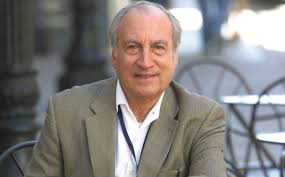 Tomás Eloy Martínez
Tomás Eloy Martínez
I seem to have had a Perón spree, starting with Joseph Page, ‘Perón: A Biography’ (1983) and then Eloy Martínez’s ‘The Perón Novel’ (1999), both reviewed elsewhere on this blog, and now this. Eva is much present in these two titles, but I wanted to read more. I did watch the A&E biography on You Tube, which was basic but not as bad as some of the illiterate comments say. Then we were given tickets to see ‘Evita’ later in the year and I decided to do some homework on Eva, starting with this one. I have one more to go, ‘The Adventures of the Busts of Eva Perón’ (2004) by Carolos Gamerro.
I read Jeane Kirkpatrick’s ‘The Perónist Movement in Argentina’ (1971) in graduate school and it left me with a curiosity about Argentina. What she argued was that historically the army made Argentina and that despite its many later corruptions and failings it remained the only legitimate institution in the society. ‘Legitimate’ means being accepted by the populace.
When I referred to a scorecard above the meaning is that it helps to know the players, some of whom I have learned of through the reading above. To read it based on Lloyd Weber, well don’t bother.
Every military coup in Argentina was justified on the ground that it would bring stability. A coup was followed by a counter-coup in one case by a single day and in another by a month. No military government lasted as long as the term of an elected government. Civilian governments, said the army officers, were unstable. The duty of the army was to bring stability. This it did in an endless parade of coups and counter-coups, sometimes between the services, Navy, Air Force, and Army, and sometimes within the Army. They shot it out, bombed Buenos Aires, and fought it out again and again. Stability is a hard thing to get out of a gun.
Skip to content
